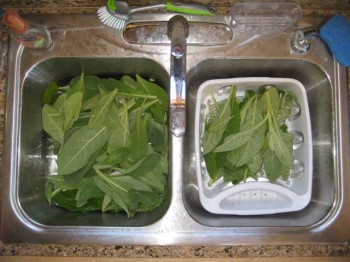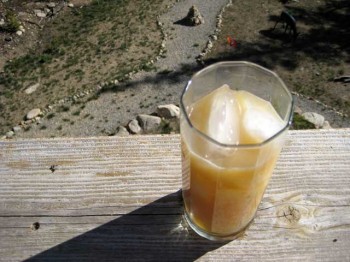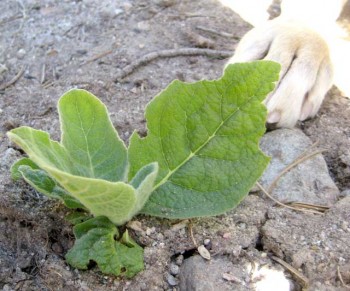
No matter which way I turn, mullein (Verbascum thapsis) seems to insert its fuzzy leaves into my life.
First there was the requested rescue mission to Aurora (on June 18), where Jim and Nancy invited me to weed out all of their mullein. Much to my excitement, there were about 20 big, healthy rosettes—a far cry from last year’s 10,000 tiny ones. This time I gathered enough mullein that when washed and laid out to dry, it covered three cookie sheets with a small mound of leaves on each one.
Of course, this brought to mind the need to do something with last year’s dried mullein leaves, of which I still have a medium-size box full.
Hot Mullein Tea
I already enjoy hot mullein tea, brewed from the fresh or dried leaves and then strained through a coffee filter to remove the fine hairs, on a regular basis. Served with milk and honey, its mild sedative effect and throat-relieving properties are said to be good for colds (March et. al., 1979).

Iced Mullein Milk Tea
I thought, if hot mullein tea, then why not cold? As the days warm, I often crave a cold, light-flavored tea or juice.
So, I lightly boiled then steeped some of last year’s dried mullein leaves until the water turned medium green, strained, added honey and a splash of milk, and set in the refrigerator to cool (where it turned the brownish color you see at right). I found the mullein milk tea to be mild but refreshing.
Gregg came home later that week and I made another batch of iced mullein milk tea, this time with the fresh leaves I collected from his parents’ landscaping. It was a weaker batch than the last (which I had loaded with leaves) and I went a little heavy on the milk, so even I admit that it tasted a bit like watered-down milk. Gregg, who is not your biggest mullein fan anyway, insisted on a taste, even though mullein usually does not interest him. He tried it, grimaced, and that was the end of it.
“You know what? I’m going to train you on iced green tea first,” I told him. “Would you drink iced green tea?” Gregg did not respond, however, as he was sucked into his computer.
I’m sold, though. Making the mullein tea strong enough is key, of course. When you do, it has a unique soft and comforting taste. I will continue to drink it—both for the taste, and also because I now have a crap-ton of it in the closet.
Iced Mullein Milk Bubble Tea
One thing I don’t think is available in Fairplay, Colorado is a tapioca—the kind used to make boba, pearl tea, or bubble tea, as it is sometimes called. I drank pearl tea all the time when I lived in Los Angeles, and frankly, I miss it. So I’ve been dreaming of making a boba of late with my newfound iced mullein milk tea. We’re heading down to Fort Collins next week and there’s a wonderful little grocery store that has authentic Asian ingredients, so hopefully I can score some there.
In the meantime, think about it—wouldn’t an iced mullein milk bubble tea be grand?
“Ew,” Gregg said when I pitched the idea to him. He can’t stand boba either. This is going to be a hard sell.

A Baby Mullein is Actually Growing in My Yard!
Two summers ago during a brief mullein obsession, I gathered some dried mullein stalks (using gloves, because the seeds are strong; they were used by native peoples as a fish paralytic) and crumbled them along with their seeds all over the rocky, dry soil around the house, which lies at 11,000 feet in the Colorado Rockies.
None of it grew.
Last summer, I painstakingly transplanted about 25 baby mullein plants from Jim and Nancy’s house in Aurora to the back and front yards. The snow has melted off them now, and they are all brown-gray and very dead-looking.
And yet, lo and behold, in a location I don’t recall sowing, a small, brand-new mullein plant is bursting its tiny way forth. The fuzzy, light green, interior leaves are unmistakably mullein, and something has been chewing on the two bigger leaves. I guess under the right conditions, mullein can grow at 11,000 feet—though it probably won’t grow too big. (I say this because we have goosefoot here too, and it grows to the height of my ankle, whereas in Fort Collins it was up to my waist last summer.)
Smoking Mullein
I didn’t know you could smoke mullein, but apparently you can—a conclusion I draw from the picture of my near-namesake, Rebecca “Wild Girl” Lerner (I think her public presence preceded me, but I swear I am innocent of name-stealing by virtue of naiveté), who is based in Portland, OR and also writes about wild edible plants. Scroll down her page for the picture, where Wild Girl with her punk rock hair is smoking on a pipe filled with mullein!
Who knows—maybe if I get bored enough and we can’t get rid of our growing mullein supply, we’ll host a smoke-fest. I think there’s even some kinnikinnik leftover. I’ll keep you posted.
In the meantime, if you want more information on mullein, please see my 2009 article, Mullein for What Ails Ya, hosted at etmarciniec.com.

I found your site and have been trying all sorts of new edibles. Verbascum thapsis is now a new one that I have been weeding and now will be using. My husband and I are trying to learn as much as we can as to what we can and should not eat on our property. We are 8500′ west of Golden and have about 93 acres. So far I now know about lambs quarters( been weeding these for years), puff balls, spruce needles, yucca….and a variety of fruits!
I have been doing some research on Prickly Pear and was wondering what you may know about them. I have been watching some that are growing lower in the canyon and they have begun to bloom yellow. All the images I find seem to look similar. If they are edible I have found some great recipes for Nopalitos, and prickly pear jelly. Do you know if these are the front range version of the prickly pear?
Any advice or help would be great!
thanks Marilyn
Hi Marilyn, I’m so glad to hear this has been helpful! Have fun with the Verbascim thapsis (but don’t consume the seeds)… Let me look into the nopalitos and prickly pears a sec before responding to that part of your question…
Rad post, and great site! Love mullein. Thank you for the blog shout out, and no worries on the similarity of our internet nicknames! Hehe 😀
In addition to my blog, you can find me at:
http://Facebook.com/UrbanForager
http://Twitter.com/UrbanForager
Also: I’m excited to try your iced mullein milk tea recipe!
Don’t think I’ll go to the trouble of mullein tea, but I’m having the best time visiting this blog — Ate some lambs quarters the other day, and really loved them. Thanks for helping me see my weedy yard as a buffet table!
Hi Marilyn, me again. Last night I read through as many prickly pear entries as I could find in my wild edible book collection. Cattail Bob Seebeck has an entry in Best-Tasting Wild Plants of Colorado and the Rocky Mountains (1998) on prickly pear (Opuntia spp.).
Yes, it grows in Colorado, and he says there aren’t any look-alikes. Yes, you can eat the juicy ripe fruit, the prickly pear itself, called “tuna” in Spanish and popular in Mexico. (I used to buy these, spines removed, from the grocery store when I lived in LA. My experience is the riper and juicier the better. Peel and eat; they’re seedy and the seeds are on the hard side, but they’re edible too.)
According to Cattail Bob, you can also eat the flat stems, which are the jointed pads that people often call “leaves” mistakenly. So I, like you, imagine that these are the mucilaginous gooey “nopales” popular south of the border. He warns that larger prickly pear clumps are over 100 years old, saying “Do not harvest from those.” Cattail Bob’s book is out of print but it’s an absolute gem for Colorado foragers. Maybe you can borrow a copy using interlibrary loan? He also gives tours though I don’t have the info on hand right now.
It sounds like the biggest difficulty with prickly pear fruits and leaves are the spines, of which there are two varieties, large spines/thorns and the thin, hair-like, glochids. “Wearing heavy work gloves, rub the fruit vigorously with a damp towel to remove all the bristles, before you even think of handling this fruit,” writes “Wildman” Steve Brill (Identifying and Harvesting Edible and Medicinal Plants in Wild (and Not So Wild) Places, 1994). Other sources say to burn or cut away the bigger thorns. Steve Brill also mentions that the fruit “turns the urine a crimson color, which is frightening if you don’t expect it.”
To be clear, then, I haven’t tried this plant in the wild—although I’d absolutely love too. Just say the word and I’ll be out at your 93 acres trying to eat cactus with you:) Cheers and good luck! And always feel free to share what you find…
WOW! thanks so much! I have to say you are welcome to come up and look around for your next meal! if I can tag along! Im pretty sure that we will be having puffball mushrooms later in the season and as we don’t do mushrooms you are welcome to them ;(
time to start harvesting prickly pears! I will pass along how the Nopalitos turn out!
happy experimenting!
Marilyn
@ Marilyn: You’re welcome! I’m suddenly busier than before, having obtained a summer position writing A&E (of all things) for our local paper. But, if we end up heading out your way I’ll send an email to you directly. Thanks for the official invite (rather than me just inviting myself, tee hee). And good luck! Don’t get spines stuck in your fingers. I just had a nasty interaction with a thistle myself.
Erica, what do you think about the differences between juicing fresh leaves and making a tea of either fresh or dried leaves?
I have genetic emphysema and am interested in seeing if this plant can help me with my lung issues.
Erwin
@Erwin: Well, I’ve never juiced (ie consumed) mullein leaves and I’m not sure I’ve read of anyone doing that either, so until further notice I personally don’t recommend it as I can’t speak from experience.
Tea, I like. I like it better with the fresh leaves when they’re in season, making sure to strain as indicated to remove the potentially-irritating fine hairs. But I definitely dry mullein too so I can have tea in the off season, and that suits me just fine. I strain that too.
Maybe consult an herbalist? I dabble in wild medicinals but don’t consider myself an authority on the topic and there may be herb combinations that could be more beneficial. Still, my understanding is that mullein is a mild herb so I hope it does something good for you.
Ha ha well okay I couldn’t just leave this posted for all these years and never try the boba tea so I finally tried it two days ago. The lesson I learned? I have no clue how to make boba. Even following the directions on the package, my pearls came out uncooked in the middle, gooey on the outside, and all stuck together. They add nothing of note to the iced mullein tea, which I still like but which is an acquired taste. Still, I force myself to eat them, my own strange ritual I guess. Try the recipe at your own risk!